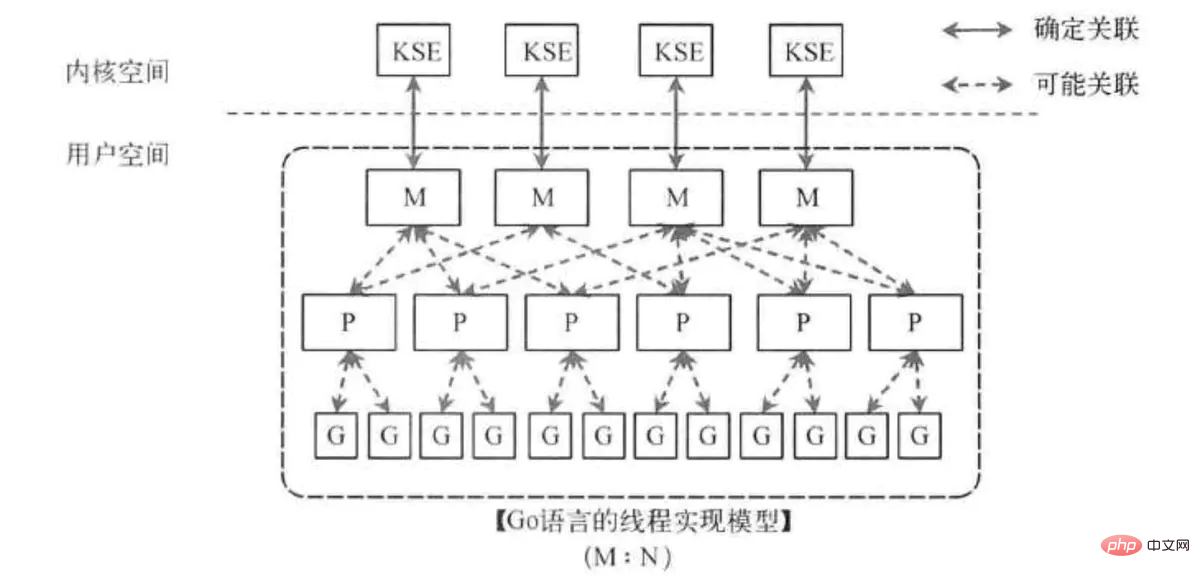When asked three times by the swoole coroutine, I almost cried!
swoole tutorialIntroduction to interview questions related to coroutines
Recommended (free): swoole tutorial
What is a process?
The process is the startup instance of the application. Independent file resources, data resources, and memory space.
What is a thread?
Threads belong to processes and are the executors of programs. A process contains at least one main thread and can also have more child threads. Threads have two scheduling strategies, one is: time-sharing scheduling, and the other is: preemptive scheduling.
My official penguin group
What is a coroutine?
Coroutines are lightweight threads, coroutines also belong to threads, and coroutines are executed in threads. The scheduling of coroutines is manually switched by the user, so it is also called user space thread. The creation, switching, suspension, and destruction of coroutines are all memory operations, and the consumption is very low. The scheduling strategy of coroutines is: collaborative scheduling.
The principle of Swoole coroutine
Swoole4 Since it is single-threaded and multi-process, there will only be one coroutine running in the same process at the same time.
Swoole server receives data and triggers the onReceive callback in the worker process to generate a Ctrip. Swoole creates a corresponding Ctrip for each request. Sub-coroutines can also be created in coroutines.
The underlying implementation of the coroutine is single-threaded, so there is only one coroutine working at the same time, and the execution of the coroutine is serial.
So when multi-tasking and multi-coroutine are executed, when one coroutine is running, other coroutines will stop working. The current coroutine will hang when performing blocking IO operations, and the underlying scheduler will enter the event loop. When an IO completion event occurs, the underlying scheduler resumes the execution of the coroutine corresponding to the event. . Therefore, coroutines do not have IO time consumption and are very suitable for high-concurrency IO scenarios. (As shown below)

Swoole’s coroutine execution process
The coroutine has no IO and is waiting for normal execution PHP code will not cause execution flow switching
When the coroutine encounters IO, it will wait and immediately switch control. After the IO is completed, the execution flow will be switched back to the original coroutine. Click
Coroutines and parallel coroutines are executed in sequence, the same logic as the previous one
Coroutine nested execution process is entered layer by layer from outside to inside until IO occurs, and then switches to the outer coroutine. The parent coroutine will not wait for the end of the child coroutine
The execution sequence of the coroutine
Let’s take a look at the basics first Example:
go(function () {
echo "hello go1 \n";});echo "hello main \n";go(function () {
echo "hello go2 \n";});go() is the abbreviation of \Co::create(), used to create a coroutine, accepting callback as a parameter, in callback The code will be executed in this newly created coroutine.
Remarks: \Swoole\Coroutine can be abbreviated to \Co
The above code Execution result:
root@b98940b00a9b /v/w/c/p/swoole# php co.phphello go1 hello main hello go2
The execution result seems to be no different from the order in which we usually write code. Actual execution process:
Run this code, the system starts a new Process
encounters
go(), a coroutine is generated in the current process,heelo go1is output in the coroutine, and the coroutine exitsThe process continues to execute the code, and outputs
hello maingenerates a coroutine, and outputs # in the coroutine ##heelo go2
, coroutine exits
// co.php<?phpsleep (100);
ps aux to view the processes in the system:
root@b98940b00a9b /v/w/c/p/swoole# php co.php &⏎ root@b98940b00a9b /v/w/c/p/swoole# ps auxPID USER TIME COMMAND 1 root 0:00 php -a 10 root 0:00 sh 19 root 0:01 fish 749 root 0:00 php co.php 760 root 0:00 ps aux ⏎
use Co;go(function () {
Co::sleep(1); // 只新增了一行代码
echo "hello go1 \n";});echo "hello main \n";go(function () {
echo "hello go2 \n";});\Co::sleep() The function function is similar to sleep(), but it simulates IO waiting (IO will be discussed in detail later). The execution result is as follows:
root@b98940b00a9b /v/w/c/p/swoole# php co.phphello main hello go2 hello go1
- Run this code, the system starts a new process
- encounters
- go()
, A coroutine is generated in the current process The coroutine encounters IO blocking (here is - Co::sleep()
simulated IO waiting), the coroutine gives up control and enters the coroutine The process scheduling queue process continues to execute downwards, outputs - hello main
- hello go2
- hello go1
go(function () {
Co::sleep(1);
echo "hello go1 \n";});echo "hello main \n";go(function () {
Co::sleep(1);
echo "hello go2 \n";});root@b98940b00a9b /v/w/c/p/swoole# php co.phphello main hello go1 hello go2 ⏎
协程快在哪? 减少IO阻塞导致的性能损失
大家可能听到使用协程的最多的理由, 可能就是 协程快. 那看起来和平时写得差不多的代码, 为什么就要快一些呢? 一个常见的理由是, 可以创建很多个协程来执行任务, 所以快. 这种说法是对的, 不过还停留在表面.
首先, 一般的计算机任务分为 2 种:
- CPU密集型, 比如加减乘除等科学计算
- IO 密集型, 比如网络请求, 文件读写等
其次, 高性能相关的 2 个概念:
- 并行: 同一个时刻, 同一个 CPU 只能执行同一个任务, 要同时执行多个任务, 就需要有多个 CPU 才行
- 并发: 由于 CPU 切换任务非常快, 快到人类可以感知的极限, 就会有很多任务 同时执行 的错觉
了解了这些, 我们再来看协程, 协程适合的是 IO 密集型 应用, 因为协程在 IO阻塞 时会自动调度, 减少IO阻塞导致的时间损失.
我们可以对比下面三段代码:
- 普通版: 执行 4 个任务
$n = 4;for ($i = 0; $i <pre class="brush:php;toolbar:false">root@b98940b00a9b /v/w/c/p/swoole# time php co.php1528965075.4608: hello 01528965076.461: hello 11528965077.4613: hello 21528965078.4616: hello 3hello main real 0m 4.02s user 0m 0.01s sys 0m 0.00s ⏎
- 单个协程版:
$n = 4;go(function () use ($n) {
for ($i = 0; $i <pre class="brush:php;toolbar:false">root@b98940b00a9b /v/w/c/p/swoole# time php co.phphello main1528965150.4834: hello 01528965151.4846: hello 11528965152.4859: hello 21528965153.4872: hello 3real 0m 4.03s
user 0m 0.00s
sys 0m 0.02s
⏎- 多协程版: 见证奇迹的时刻
$n = 4;for ($i = 0; $i <pre class="brush:php;toolbar:false">root@b98940b00a9b /v/w/c/p/swoole# time php co.phphello main1528965245.5491: hello 01528965245.5498: hello 31528965245.5502: hello 21528965245.5506: hello 1real 0m 1.02s user 0m 0.01s sys 0m 0.00s ⏎
为什么时间有这么大的差异呢:
普通写法, 会遇到 IO阻塞 导致的性能损失
单协程: 尽管 IO阻塞 引发了协程调度, 但当前只有一个协程, 调度之后还是执行当前协程
多协程: 真正发挥出了协程的优势, 遇到 IO阻塞 时发生调度, IO就绪时恢复运行
我们将多协程版稍微修改一下:
- 多协程版2: CPU密集型
$n = 4;for ($i = 0; $i <pre class="brush:php;toolbar:false">root@b98940b00a9b /v/w/c/p/swoole# time php co.php1528965743.4327: hello 01528965744.4331: hello 11528965745.4337: hello 21528965746.4342: hello 3hello main real 0m 4.02s user 0m 0.01s sys 0m 0.00s ⏎
只是将 Co::sleep() 改成了 sleep(), 时间又和普通版差不多了. 因为:
sleep()可以看做是 CPU密集型任务, 不会引起协程的调度Co::sleep()模拟的是 IO密集型任务, 会引发协程的调度
这也是为什么, 协程适合 IO密集型 的应用.
再来一组对比的例子: 使用 redis
// 同步版, redis使用时会有 IO 阻塞$cnt = 2000;for ($i = 0; $i connect('redis');
$redis->auth('123');
$key = $redis->get('key');}// 单协程版: 只有一个协程, 并没有使用到协程调度减少 IO 阻塞go(function () use ($cnt) {
for ($i = 0; $i connect('redis', 6379);
$redis->auth('123');
$redis->get('key');
}});// 多协程版, 真正使用到协程调度带来的 IO 阻塞时的调度for ($i = 0; $i connect('redis', 6379);
$redis->auth('123');
$redis->get('key');
});}性能对比:
# 多协程版root@0124f915c976 /v/w/c/p/swoole# time php co.phpreal 0m 0.54s user 0m 0.04s sys 0m 0.23s ⏎# 同步版root@0124f915c976 /v/w/c/p/swoole# time php co.phpreal 0m 1.48s user 0m 0.17s sys 0m 0.57s ⏎
swoole 协程和 go 协程对比: 单进程 vs 多线程
接触过 go 协程的 coder, 初始接触 swoole 的协程会有点 懵, 比如对比下面的代码:
package main
import (
"fmt"
"time")func main() {
go func() {
fmt.Println("hello go")
}()
fmt.Println("hello main")
time.Sleep(time.Second)}> 14:11 src $ go run test.go hello main hello go
刚写 go 协程的 coder, 在写这个代码的时候会被告知不要忘了 time.Sleep(time.Second), 否则看不到输出 hello go, 其次, hello go与 hello main 的顺序也和 swoole 中的协程不一样.
原因就在于 swoole 和 go 中, 实现协程调度的模型不同.
上面 go 代码的执行过程:
- 运行 go 代码, 系统启动一个新进程
- 查找
package main, 然后执行其中的func mian() - 遇到协程, 交给协程调度器执行
- 继续向下执行, 输出
hello main - 如果不添加
time.Sleep(time.Second), main 函数执行完, 程序结束, 进程退出, 导致调度中的协程也终止
go 中的协程, 使用的 MPG 模型:
- M 指的是 Machine, 一个M直接关联了一个内核线程
- P 指的是 processor, 代表了M所需的上下文环境, 也是处理用户级代码逻辑的处理器
- G 指的是 Goroutine, 其实本质上也是一种轻量级的线程

而 swoole 中的协程调度使用 单进程模型, 所有协程都是在当前进程中进行调度, 单进程的好处也很明显 – 简单 / 不用加锁 / 性能也高.
无论是 go 的 MPG模型, 还是 swoole 的 单进程模型, 都是对 CSP理论 的实现.
The above is the detailed content of When asked three times by the swoole coroutine, I almost cried!. For more information, please follow other related articles on the PHP Chinese website!

Hot AI Tools

Undresser.AI Undress
AI-powered app for creating realistic nude photos

AI Clothes Remover
Online AI tool for removing clothes from photos.

Undress AI Tool
Undress images for free

Clothoff.io
AI clothes remover

AI Hentai Generator
Generate AI Hentai for free.

Hot Article

Hot Tools

Notepad++7.3.1
Easy-to-use and free code editor

SublimeText3 Chinese version
Chinese version, very easy to use

Zend Studio 13.0.1
Powerful PHP integrated development environment

Dreamweaver CS6
Visual web development tools

SublimeText3 Mac version
God-level code editing software (SublimeText3)

Hot Topics
 1378
1378
 52
52
 How do I extend Swoole with custom modules?
Mar 18, 2025 pm 03:57 PM
How do I extend Swoole with custom modules?
Mar 18, 2025 pm 03:57 PM
Article discusses extending Swoole with custom modules, detailing steps, best practices, and troubleshooting. Main focus is enhancing functionality and integration.
 How can I use Swoole's memory pool to reduce memory fragmentation?
Mar 17, 2025 pm 01:23 PM
How can I use Swoole's memory pool to reduce memory fragmentation?
Mar 17, 2025 pm 01:23 PM
The article discusses using Swoole's memory pool to reduce memory fragmentation by efficient memory management and configuration. Main focus is on enabling, sizing, and reusing memory within the pool.
 How do I configure Swoole's process isolation?
Mar 18, 2025 pm 03:55 PM
How do I configure Swoole's process isolation?
Mar 18, 2025 pm 03:55 PM
Article discusses configuring Swoole's process isolation, its benefits like improved stability and security, and troubleshooting methods.Character count: 159
 How do I use Swoole's asynchronous I/O features?
Mar 18, 2025 pm 03:56 PM
How do I use Swoole's asynchronous I/O features?
Mar 18, 2025 pm 03:56 PM
The article discusses using Swoole's asynchronous I/O features in PHP for high-performance applications. It covers installation, server setup, and optimization strategies.Word count: 159
 How can I contribute to the Swoole open-source project?
Mar 18, 2025 pm 03:58 PM
How can I contribute to the Swoole open-source project?
Mar 18, 2025 pm 03:58 PM
The article outlines ways to contribute to the Swoole project, including reporting bugs, submitting features, coding, and improving documentation. It discusses required skills and steps for beginners to start contributing, and how to find pressing is
 How does Swoole's reactor model work under the hood?
Mar 18, 2025 pm 03:54 PM
How does Swoole's reactor model work under the hood?
Mar 18, 2025 pm 03:54 PM
Swoole's reactor model uses an event-driven, non-blocking I/O architecture to efficiently manage high-concurrency scenarios, optimizing performance through various techniques.(159 characters)
 How can I use Swoole to build a microservices architecture?
Mar 17, 2025 pm 01:18 PM
How can I use Swoole to build a microservices architecture?
Mar 17, 2025 pm 01:18 PM
Article discusses using Swoole for microservices, focusing on design, implementation, and performance enhancement through asynchronous I/O and coroutines.Word count: 159
 What tools can I use to monitor Swoole's performance?
Mar 18, 2025 pm 03:52 PM
What tools can I use to monitor Swoole's performance?
Mar 18, 2025 pm 03:52 PM
The article discusses tools and best practices for monitoring and optimizing Swoole's performance, and troubleshooting methods for performance issues.





